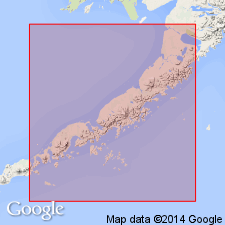
- Usage in publication:
-
- Bear Lake Formation
- Modifications:
-
- Original reference
- Dominant lithology:
-
- Sandstone
- Conglomerate
- AAPG geologic province:
-
- Alaska Peninsula province
- Alaska Southwestern region
Summary:
Pt. 1, p. 89-92, 97, 100; Pt. 2, maps. Bear Lake Formation. A thick sequence of interbedded sandstones, conglomerates, and a few siltstones is exposed along eastern shores of Port Moller and in mountains to northeast, well beyond Bear Lake. Locally beds carry abundant marine fauna of middle and late Miocene age. Sequence is here named Bear Lake Formation. Thickness at least 5,000 feet, may possibly be twice this much. In type area includes Unga Conglomerate Member at base. Unconformably overlies Stepovak Formation (of Beaver Bay Group) (new), but in many exposures exact contact is problematical; overlain by several hundred feet of coarse volcanic breccias and thick volcanic flows.
Type locality: exposures in mountains above and eastward from Bear Lake, Port Moller-Unga area, Alaska Peninsula, southwestern AK.
Source: US geologic names lexicon (USGS Bull. 1350, p. 51); supplemental information from GNU records (USGS DDS-6; Menlo GNULEX).
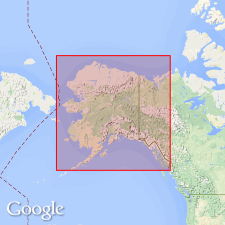
- Usage in publication:
-
- Bear Lake Formation*
- Modifications:
-
- Adopted
- Age modified
- Biostratigraphic dating
- AAPG geologic province:
-
- Alaska Peninsula province
- Alaska Southwestern region
Summary:
Bear Lake Formation of Burk (1965) is herein adopted. MYTILUS n. sp. occurs in provincial middle(?) and late Miocene deposits of Bear Lake Formation (upper part of Unga Conglomerate Member and upward into middle part of formation). Age is middle(?) and late Miocene.
Source: GNU records (USGS DDS-6; Menlo GNULEX).
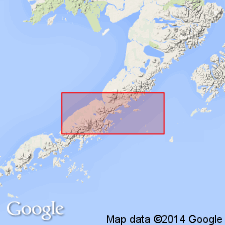
- Usage in publication:
-
- Bear Lake Formation*
- Modifications:
-
- Areal extent
- AAPG geologic province:
-
- Alaska Peninsula province
- Alaska Southwestern region
Summary:
Type locality here clarified as on southeast slopes (secs.27-28 T48S R69W) of mountain 10 km east of Bear Lake, Chignik A-7 and Port Moller D-1 quads, Alaska Peninsula, AK. Consists of inner neritic and nonmarine sandstone, conglomerate, shale, and thin coal beds. Rocks are dark-brown to pale yellowish-brown. Abundantly fossiliferous in upper part. Unconformably overlies Meshik and Tolstoi Formations; unconformably underlies Milky River Formation. Measured section, lists of fossils and fossil locations on map of study area included in report.
Source: GNU records (USGS DDS-6; Menlo GNULEX).
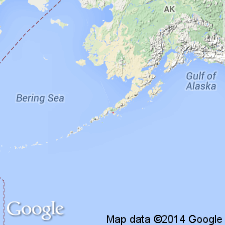
- Usage in publication:
-
- Bear Lake Formation*
- Modifications:
-
- Age modified
- Biostratigraphic dating
- AAPG geologic province:
-
- Alaska Peninsula province
- Alaska Southwestern region
Summary:
Overall age of Bear Lake Formation is early(?), middle(?), and late Miocene on basis of early and/or middle Miocene age of Unga Conglomerate Member in which TYRANNOBERINGIUS REX was found.
Source: GNU records (USGS DDS-6; Menlo GNULEX).
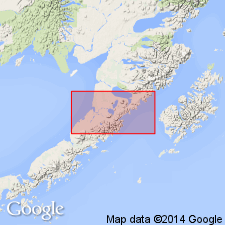
- Usage in publication:
-
- Bear Lake Formation*
- Modifications:
-
- Biostratigraphic dating
- AAPG geologic province:
-
- Alaska Peninsula province
- Alaska Southwestern region
Summary:
Age in report area (sections of Ugashik, Bristol Bay and part of Karluk quads) is considered middle(?) and late Miocene owing to absence of the early and/or middle Miocene Unga Conglomerate Member. [Overall unit age remains early(?), middle(?), and late Miocene.]
Source: GNU records (USGS DDS-6; Menlo GNULEX).
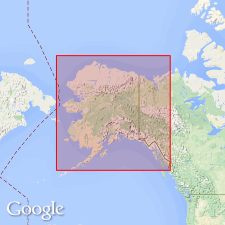
- Usage in publication:
-
- Bear Lake Formation*
- Modifications:
-
- Age modified
- Biostratigraphic dating
- AAPG geologic province:
-
- Alaska Peninsula province
- Alaska Southwestern region
Summary:
TURRITELLA (HATAIELLA) SAGAI is first reliable evidence for an age as great as earliest middle Miocene for strata in Bear Lake Formation on Ukolnoi Island. Base of Bear Lake Formation is not exposed on island so an unknown thickness of this formation is older than interval bearing T. (H.) SAGAI. [Overall unit age is early(?), middle, and late Miocene.]
Source: GNU records (USGS DDS-6; Menlo GNULEX).
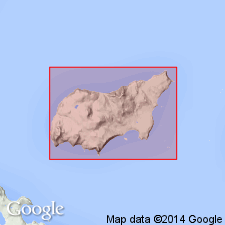
- Usage in publication:
-
- Bear Lake Formation*
- Modifications:
-
- Age modified
- Areal extent
- AAPG geologic province:
-
- Alaska Peninsula province
- Alaska Southwestern region
Summary:
Occurrence of TURRITELLA (HATAIELLA) SAGAI on Alaska Peninsula mainland provides correlation with Ukolnoi Island strata and indicates mainland outcrop is also of earliest middle Miocene age. Similar age is suggested for additional outcrop on an unnamed peninsula to northeast of Cape Aliaksin on adjacent Alaska Peninsula mainland. Age of Unga Conglomerate Member on Cape Aliaksin is middle Miocene based on correlation with molluscan species on Ukolnoi Island, age refinement of molluscan stages by Addicott (1981) and K-Ar age of 10.4 +/-0.49 Ma for overlying andesite flow. [Overall unit age is middle and late Miocene.]
Source: GNU records (USGS DDS-6; Menlo GNULEX).
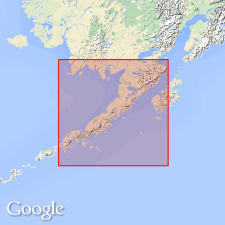
- Usage in publication:
-
- Bear Lake Formation*
- Modifications:
-
- Revised
- AAPG geologic province:
-
- Alaska Peninsula province
- Alaska Southwestern region
Summary:
Bear Lake Formation. Unit stratigraphically restricted; its former Unga Conglomerate Member is everywhere raised to formation rank. Age remains middle and late Miocene.
Source: GNU records (USGS DDS-6; Menlo GNULEX).
For more information, please contact Nancy Stamm, Geologic Names Committee Secretary.
Asterisk (*) indicates published by U.S. Geological Survey authors.
"No current usage" (†) implies that a name has been abandoned or has fallen into disuse. Former usage and, if known, replacement name given in parentheses ( ).
Slash (/) indicates name conflicts with nomenclatural guidelines (CSN, 1933; ACSN, 1961, 1970; NACSN, 1983, 2005, 2021). May be explained within brackets ([ ]).

